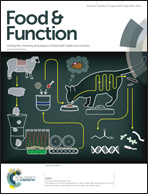Epigallocatechin gallate induces GLUT4 translocation in skeletal muscle through both PI3K- and AMPK-dependent pathways
Abstract
Our previous report demonstrated that epigallocatechin gallate (EGCg) promotes translocation of glucose transporter 4 (GLUT4) in skeletal muscle. In this study, we investigated the molecular mechanism of GLUT4 translocation by EGCg at the physiological concentration range. In L6 cells, EGCg induced phosphorylation of phosphatidylinositide 3′-kinase (PI3K) and downstream protein kinase C (PKC) λ/ξ without affecting the phosphorylation of insulin receptor and Akt. EGCg-induced GLUT4 translocation was suppressed by RNA interference-mediated knockdown of PI3K and treatment with PKC inhibitor Go6983. Moreover, EGCg increased Rac1 activity and actin remodelling as downstream events of PKCλ/ξ. These results indicate that EGCg induced GLUT4 translocation through a PI3K-dependent pathway, but its mode of action differed from that of insulin. EGCg also induced GLUT4 translocation through a 5′-adenosine monophosphate-activated protein kinase (AMPK)-dependent pathway. 67 kDa laminin receptor, which is a target molecule of EGCg, was not involved in EGCg-induced glucose uptake in L6 cells. The oral administration of EGCg suppressed postprandial hyperglycaemia accompanied by GLUT4 translocation through both PI3K- and AMPK-dependent pathways, and promoted glycogen accumulation in skeletal muscle of ICR mice. EGCg promotes GLUT4 translocation through both PI3K- and AMPK-dependent pathways and glycogen accumulation in skeletal muscle.



 Please wait while we load your content...
Please wait while we load your content...